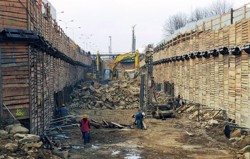
Rider bracing (berliner bracing) is a method of temporary sheeting of foundation pit walls above the underground water level. This sheeting consists of riders, sheeting boards and possibly anchors carried out over steel strap anchors.
Riders are elements made of steel rolled sections that are set into rock, either into pre-drilled holes, or they are rammed (vibrated) under the level of a prospective foundation pit bottom. Profiles I, 2 x U, their weldings, or HEB profiles are the most commonly used riders. In the process of setting riders it is necessary to keep their mutual distances designed according to a static calculation (usually 1,8 to 2,5 m), their verticality and orientation in the course of setting. A rider set into a hole is fixed by a filling of lower strenght class dry concrete in the depth under the level of a prospective foundation pit bottom and by a filling of non-cohesive material up to the level of existing ground. If the rider is to be pulled out of the hole after the termination of its functioning, it must be treated against adhesion to the concrete.
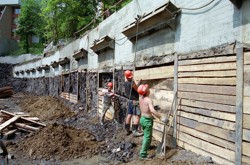 Sheeting boards fill spaces between riders. With the development of excavation works in a foundation pit sheeting boards are inserted between riders. Their function is to create a wall resistant to earth pressure. Sheeting boards are normally made from wood - either from round timber or from squared wood, it is, however, also possible to use steel sheeting boards. They are wedged with wooden wedges against flanges of braces to achieve their full contact with the sheeted soil. The progress of earthworks and sheeting itself needs to be coordinated so that the foundation pit wall created by the drawn soil was not left without sheeting: a) for a period longer than determined in the project, b) to a bigger height than projected. The space incurred between the excavation walls and sheeting boards must be filled with a suitable material, immediately after the sheeting boards are inserted, to ensure a contact of the sheeting construction with natural soil behind the sheeting and to prevent a drop or slide of the excavation wall, which would, in most cases induce damage of surrounding subjects.
Sheeting boards fill spaces between riders. With the development of excavation works in a foundation pit sheeting boards are inserted between riders. Their function is to create a wall resistant to earth pressure. Sheeting boards are normally made from wood - either from round timber or from squared wood, it is, however, also possible to use steel sheeting boards. They are wedged with wooden wedges against flanges of braces to achieve their full contact with the sheeted soil. The progress of earthworks and sheeting itself needs to be coordinated so that the foundation pit wall created by the drawn soil was not left without sheeting: a) for a period longer than determined in the project, b) to a bigger height than projected. The space incurred between the excavation walls and sheeting boards must be filled with a suitable material, immediately after the sheeting boards are inserted, to ensure a contact of the sheeting construction with natural soil behind the sheeting and to prevent a drop or slide of the excavation wall, which would, in most cases induce damage of surrounding subjects.
The process of carrying out rider bracing of a foundation pit
1a) drilling and setting of riders;
1b) excavation to the 1st anchoring level, gradual setting of sheeting boards, drilling away, setting and loading of anchors;
1c) excavation continued to the 2nd anchoring level, gradual setting of sheeting boards, finished excavation to the foundation level,finalised setting of sheeting boards.
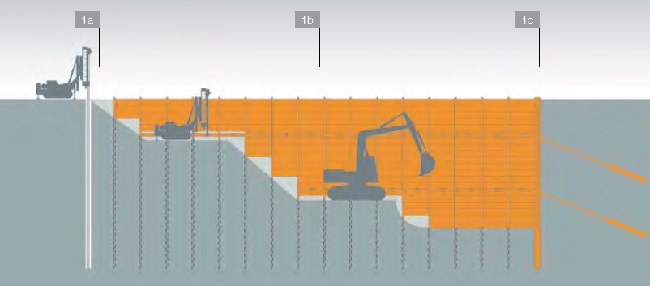
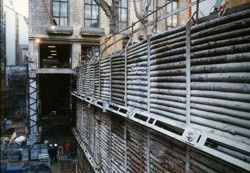 The stability of rider walls, especially in deeper excavations, is secured by anchoring. Strand ground anchors set over steel strap anchors are used for this purpose. These are usually girders made of steel sections that usually overlap two or more riders and form a supporting construction for anchor heads. Cross-braces represent another way of securing stability of rider sheeting. They are usually carried out from steel pipes. A sheeting construction is normally strutted in corners and alcoves, where the realisation of anchoring would be difficult. Design engineers and investors more and more often set requirements for dismounting of rider bracing after the termination of its functioning.
The stability of rider walls, especially in deeper excavations, is secured by anchoring. Strand ground anchors set over steel strap anchors are used for this purpose. These are usually girders made of steel sections that usually overlap two or more riders and form a supporting construction for anchor heads. Cross-braces represent another way of securing stability of rider sheeting. They are usually carried out from steel pipes. A sheeting construction is normally strutted in corners and alcoves, where the realisation of anchoring would be difficult. Design engineers and investors more and more often set requirements for dismounting of rider bracing after the termination of its functioning.
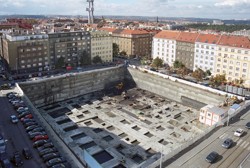 Dismounting is carried out in two stages- at first, anchors need to be deactivated and the cross beams removed, then after complete filling of space between the rider bracing and built-in object the steel riders are excavated. A vibrating pile driver is commonly used for pulling out riders as it looses them. Sheeting boards cannot be, in most cases, dismounted out of the excavation and they become a permanent part of the filling. A method of anchoring rider walls with inserted strap anchors where neither the anchor head over laps the inside sheeting face has been successfully used recently. This method makes it possible to carry out a continual plane layer of shotcrete on the rider bracing, which creates a suitable surface for laying an external insulation of the prospective building.
Dismounting is carried out in two stages- at first, anchors need to be deactivated and the cross beams removed, then after complete filling of space between the rider bracing and built-in object the steel riders are excavated. A vibrating pile driver is commonly used for pulling out riders as it looses them. Sheeting boards cannot be, in most cases, dismounted out of the excavation and they become a permanent part of the filling. A method of anchoring rider walls with inserted strap anchors where neither the anchor head over laps the inside sheeting face has been successfully used recently. This method makes it possible to carry out a continual plane layer of shotcrete on the rider bracing, which creates a suitable surface for laying an external insulation of the prospective building.
Combined anchored sheeting formed by a monolithic diaphragm wall
in the bottom part and by a standard rider bracing in the upper part
